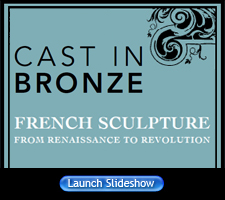|
This exhibition represents an overview of three centuries of French bronze sculpture, when monarchs and private collectors came to embrace bronze as a valuable and appropriate material for both monumental and miniature sculpture. Countless masterpieces—especially those with royal associations—were damaged or destroyed during the French Revolution, but those that survive testify to the French genius for bronze.
The exhibition is arranged chronologically, following the reigns of French monarchs, from the House of Valois in the mid-1500s, through the Bourbon rule of the 1600–1700s, and until the demise of the monarchy in 1792 during the French Revolution.
|
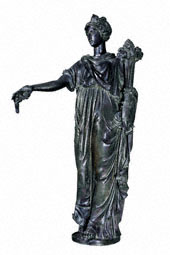
 |
 |
Abundance or Felicity, Barthélemy Prieur, 1571
|
 |
 |
|
|
 |
The flourishing of bronze sculpture in 16th-century France is closely tied to the presence of Italian sculptors and painters at the court of the Valois king François I (ruled 1515–1547) in the 1540s. Employing local foundries, these artists' activities revolutionized the production and stylistic development of the French bronze and introduced a taste for secular subject matter in monumental sculpture. During the 1500s bronze was increasingly adopted as a costly and enduring material for use in large-scale French funerary monuments.
French artist Barthélemy Prieur had traveled to Italy to study ancient sculpture and this draped figure reflects the influence of ancient Roman art. Representing either Abundance or Felicity, this allegorical figure was originally accompanied by allegories of Peace and Justice. The three bronzes were created for the base of a funerary monument designed to hold the heart of the deceased Constable of France, Anne de Montmorency (1493–1567).
|
 |

 |
 |
Louis XIV's Left Foot (fragment of Equestrian Statue of Louis XIV), François Girardon, 1692–94
|
 |
 |
|
 |
|
 |
|
This foot is a fragment of a 30-foot high equestrian monument to Louis XIV, erected in 1699 on Place Louis-le-Grand (present-day Place Vendôme) in Paris. Most of the monuments erected in honor of Louis XIV—a great patron of the arts—were cast in bronze, a noble and costly metal that defied the effects of exposure to the elements better than marble. The ancient equestrian monument to Marcus Aurelius in Rome served as a model from the Renaissance onward for the equestrian statues Italian princes had erected, and also became a model for French artists. Such monuments of French kings, starting from Henri IV, were cast in bronze and installed throughout the city of Paris and around France.
The finished sculpture from which this foot of Louis XIV came was destroyed in 1792 during the French Revolution (1789–99), which marked the end of the absolute monarchy in France. During the Revolution, equestrian and standing monuments to Henry IV, Louis XIV, and Louis XV were pulled down in the squares of Paris and other French cities.
|
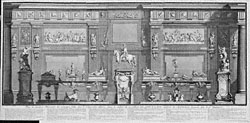
 |
 |
View of the Gallery of Girardon (in French), Nicholas Chevalier (after René Charpentier), 1709.
Image © The Metropolitan Museum of Art
|
 |
 |
Bronze sculpture was highly appreciated throughout the 1700s, since few individuals were rich enough to acquire monumental marble statues. Bronze casting allowed sculptors to provide precious ornaments for collectors and to popularize their most successful pieces.
This engraving shows a display of bronze statuettes from artist François Girardon's personal collection. Girardon collaborated with the principal casters of Louis XIV's reign on important artistic projects. Himself a master of bronze-casting techniques, Girardon supervised the casting of copies after both ancient statues and contemporary works. Under his direction and after his own models, important marble statues at Versailles (the king's palace outside Paris) were also executed, from which small bronzes statues were cast.
A great collector, Girardon owned some 800 works of art. In his gallery at the Louvre Palace in Paris he kept bronze statuettes after his own sculptures, as well as ancient statues and works by other sculptors. Engravings like the one seen here show Girardon's ideal display of these works of art.
|
 |
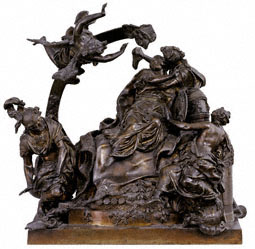
 |
 |
The Death of Dido, François Lespingola, before 1705
|
 |
 |
|
The French bronze reached the peak of its popularity in the later years of Louis XIV's reign and the Régence period (1715–23). Small versions of famous sculptures were popular, as were bronzes conceived for private galleries or cabinets. Classical mythological subjects predominate, as do themes of honor, love, and passion. Such concerns were integral to contemporary French opera, dance, and theater, and were at the heart of court culture. Honor was won through the great deeds of a prince, hero, or god. Ideal love was constant and courageous; passion could lead to downfall. The mythological figures depicted in French bronzes were invested with the same graceful postures and gestures adopted by actors playing them on the French stage, and were often arranged in dramatic groupings.
Here Dido, queen of Carthage, desperate at her lover Aeneas's departure, has just stabbed herself with his sword. Her sister tries to comfort her as she dies, lying next to Aeneas's armor and a shield with his effigy. A servant and a warrior step back from the funeral pyre. Iris, sent by Juno (queen of the gods), arrives on a rainbow to cut some of her hair, thus liberating her soul.
|
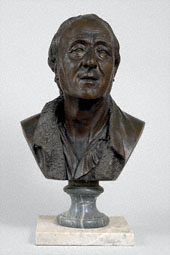
 |
 |
Denis Diderot, Jean-Baptiste Pigalle, 1777
|
 |
 |
The Enlightenment, also known as the Age of Reason, spanned the 18th century and was a time of profound intellectual exchange and discovery in the sciences, arts, and philosophy. The philosophers Voltaire and Jean-Jacques Rousseau explored the value of individual rights in their writings, and their ideas, combined with those of other Enlightenment figures, incited important social, political, and economic transformations leading up to and during the French Revolution.
The Enlightenment interest in the rights of the individual coincided with the rise of privately commissioned sculptural portrait busts. The technical and stylistic innovations of artists turned sculpted portraits into an ambitious artistic genre with its own conventions and traditions. The reproductive quality of bronze made it possible for private patronage to rival royal commissions and for every public space to have a portrait of Voltaire, Rousseau, and Denis Diderot.
Diderot, the editor of the multivolume Encyclopedia (1751–1772), and considered the first art critic, is depicted here at age 63. With unparalleled immediacy, Pigalle recorded the philosopher's declining health: deep rings under his eyes, wrinkles on the face, and hollow cheeks. In addition to expressing the physical realism preferred during the Enlightenment, Pigalle followed 18th-century conventions for portraits of philosophers by depicting Diderot without his wig and with his collar open, introducing a level of informality.
This exhibition highlights the work of an international group of art historians, conservators, scientists, and connoisseurs—known as the French Bronze Study Group—who have devoted several years to an unprecedented in-depth study of French bronzes. The new research and discoveries of the group have made this exhibition possible, together with the exceptional loans granted by Her Majesty Queen Elizabeth II, the Musée du Louvre, the Metropolitan Museum of Art, the Dresden State Art Collections, and the Château de Versailles, as well as several other public and private collections.
This exhibition has been co-organized by the J. Paul Getty Museum; The Metropolitan Museum of Art, New York; and the Musée du Louvre, Paris. This exhibition is supported by an indemnity from the Federal Council on the Arts and the Humanities.
|
